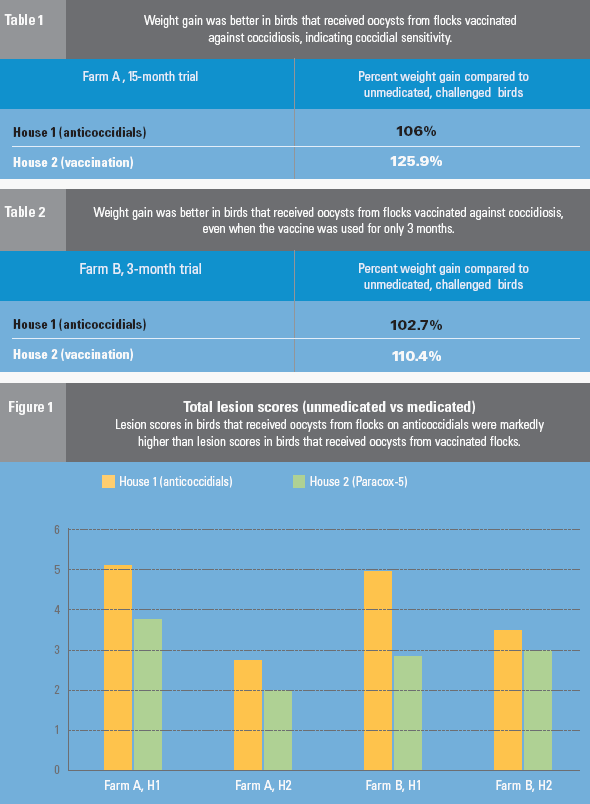
Second Wind
 "The use of Paracox-5
vaccine, over time, can help restore sensitivity to anticoccidial medication - hence, 'Revitalization'."
"The use of Paracox-5
vaccine, over time, can help restore sensitivity to anticoccidial medication - hence, 'Revitalization'."
DR. RALPH MARSHALL
Two controlled trials conducted in the United Kingdom have demonstrated that over time, coccidial sensitivity to infeed
anticoccidials can be revitalized with the use of a live attenuated coccidiosis vaccine.
That was the conclusion of Dr. Ralph Marshall, a renowned coccidiosis researcher with the Veterinary Laboratories Agency (VLA), UK.
Resistance to in-feed anticoccidials
has resulted from prolonged or incorrect use of in-feed
anticoccidials and leads to poor performance in broilers and loss of income for producers, he said.
Anticoccidial resistance is a growing concern and is having a "major impact on operations worldwide," Marshall continued, which is why trials were conducted at two commercial poultry farms in the UK.
On each of the farms, one house received the in-feed anticoccidials
nicarbazin and narasin followed by the ionophore monensin and a second house
was vaccinated on day 1 with a single dose of Paracox-5,
a live attenuated coccidiosis vaccine designed for broilers. The vaccine was administered either by spraying it on feed or directly onto chicks at the hatchery.
VLA performed anticoccidial sensitivity testing (AST) by challenging various groups of birds with coccidial oocysts recovered from feces at trial houses. Researchers then evaluated weight gain and coccidial lesions in challenged birds and in unmedicated, challenged controls in the study, which was sponsored by Schering-Plough Animal Health.
Clear differences
"Results from both farms showed that there was a clear difference in weight gain responses and lesion scores between groups of birds infected with oocysts from medicated and vaccinated houses," Marshall said.
On Farm A, birds that received oocysts from the vaccinated flock gained more weight than birds that received oocysts from the flock that received anticoccidials when compared to weight in unmedicated, challenged control birds (Table 1), Marshall said.
The results demonstrate that oocysts in birds that received anticoccidials were resistant to anticoccidials, and that oocysts in vaccinated birds were susceptible to
the use of Paracox-5 anticoccidials,
he said.
On Farm B, the results were similar. Birds that received oocysts from the vaccinated flock gained more weight than birds that received oocysts from the flock
that received anticoccidials (Table 2). In this case, the difference in weight gain between houses was not as great as on Farm A, indicating that the oocysts in vaccinated birds were "mildly susceptible," Marshall reported.
The difference between the two studies in the degree of sensitivity could be attributed to the length of time that the vaccine was used, he said. On Farm A, the vaccine or anticoccidials were used for 15 months. On Farm B, they were used for 3 months, he said.
Lesion scores bolstered the sensitivity findings, Marshall continued (Figure 1). "Lesions from houses on anticoccidials were markedly higher than those in birds on Paracox-5,
and lesions from houses on Paracox-5 were reduced for all species of
Eimeria," he said.
Marshall concludes that "The use of Paracox-5 vaccine,
over time, can help restore sensitivity to anticoccidial medication — hence, 'Revitalization'." Ultimately, the benefits can include improved bird performance and reduction in the use of anticoccidials.
The vaccine has some other advantages, he added. It can be given at day-of-age by a variety
of methods including gavage, on feed or by hatchery spray. It causes oocysts to circulate in the litter, which enables birds to naturally develop immunity against coccidiosis via "trickle infection." One dose of the vaccine provides lifetime protection, and there is no withdrawal period or concerns about environmental contamination as there is with in-feed medications.
 |
One dose
of the vaccine
provides lifetime
protection,
and there
is no
withdrawal
period or
concerns
about
environmental
contamination
as there
is with
in-feed
medications.
|
Coccidiosis control improved by rotating vaccine in German study
Improved coccidiosis control—even on broiler farms with a high coccidiosis challenge — can be achieved by rotating coccidiosis vaccination with traditional anticoccidials, said Dr. Ulrich Löhren of PHW Zentrallabor der Fa. Wiesenhof, Germany.
Löhren and associates conducted a study on four farms with a high coccidiosis challenge characterized by clinical outbreaks of
Eimeria tenella despite the use of in-feed
anticoccidials. The farms all thinned their flocks, and birds were reared to either 1.5 kg (3.3. lbs) at 31 to 34 days or 2.0 kg (5.3 lbs) at 36 to 40 days.
The coccidiosis vaccine Paracox-5 was used for three consecutive cycles and was applied as a hatchery spray or was sprayed on feed at day of age. The houses were disinfected before the first vaccination but no disinfectant was used between subsequent vaccinated flocks. The IDEA nutritional concept (CocciForum, No. 9) for birds, which promotes a high quality diet starting early in life as well as highly digestible feed, was implemented.
After vaccination, researchers conducted weekly oocyst counts and recorded weight gain and feed conversion. In addition, they performed anticoccidial sensitivity testing (AST) on Eimeria isolates from the last vaccinated flocks in the study, sponsored by Schering-Plough Animal Health.

"Clinical coccidiosis was well controlled," Löhren said, and did not occur in flocks after rotating back to the anticoccidials. On one farm, bloody droppings were observed in the first vaccinated grow-out, but not in subsequent vaccinated flocks, he noted.
After vaccination, bird performance improved from flock to flock and was best in heavy birds (2.0 kg or 4.4 lbs and above) but also good in light birds
(1.5 kg or 3.3 lbs) compared to previously unvaccinated flocks. Moreover, there were good results in the next flocks treated with anticoccidials and a higher degree of anticoccidial sensitivity.
"Vaccination is a viable option for improved coccidiosis control while seeding the house with sensitive Eimeria, thus enhancing the efficacy of in-feed anticoccidials,
even in birds reared to low weights," Löhren concluded.
The development of immunity against coccidia after vaccination prevents resident house Eimeria field populations from multiplying effectively. Ultimately, sensitive vaccine strains of Paracox-5
dilute the more pathogenic and resistant house strains, resulting in an overall Eimeria population that is less pathogenic and more sensitive to anticoccidials (Figure 1), he said.
Restoring sensitivity to anticoccidials is important, Löhren added, because coccidiosis remains a widespread problem in broilers and in Europe, the number of available anticoccidials has decreased, limiting the possibility for rotation and resting of remaining anticoccidials. In addition, resistance to in-feed anticoccidials is
common and has been confirmed by recent anticoccidial drug profiles, he said.
Strong case made for vaccine with antigenic diversity
The most effective way to vaccinate against coccidiosis due to the coccidial species Eimeria maxima is to use a vaccine that has two immunologically distinct lines of the species, said Dr. Luciano Gobbi, an Italy-based technical
service manager with Schering-Plough Animal Health.
E. maxima is a highly immunogenic species and results in rapid protection against homologous challenge. In other words, immunization with one species is likely to induce rapid protection against the same species. However, there is marked antigenic diversity among E. maxima isolates and when they are used as heterologous challenges, the level of protection is poor; one strain of
E. maxima is unlikely to protect against another strain of this species, he said.
The extent of immunologically unrelated strains of E. maxima has not been fully investigated, but research to date indicates that antigenic diversity, or variants, with this coccidial species is relatively common. However, live coccidiosis vaccines may fail against heterologous challenge if the species of E. maxima has different DNA than species in the vaccine, Gobbi explained.
One approach for controlling E. maxima would be to use advanced tools, such as the DNA test known as polymerase chain reaction (PCR), to determine which
E. maxima strains exist on a farm. That in turn could help determine whether mass vaccination would be beneficial. The more practical solution, however, would be to use a vaccine that contains two distinct E. maxima lines, Gobbi said.
Spring 2008
Back to European Edition (#1)












